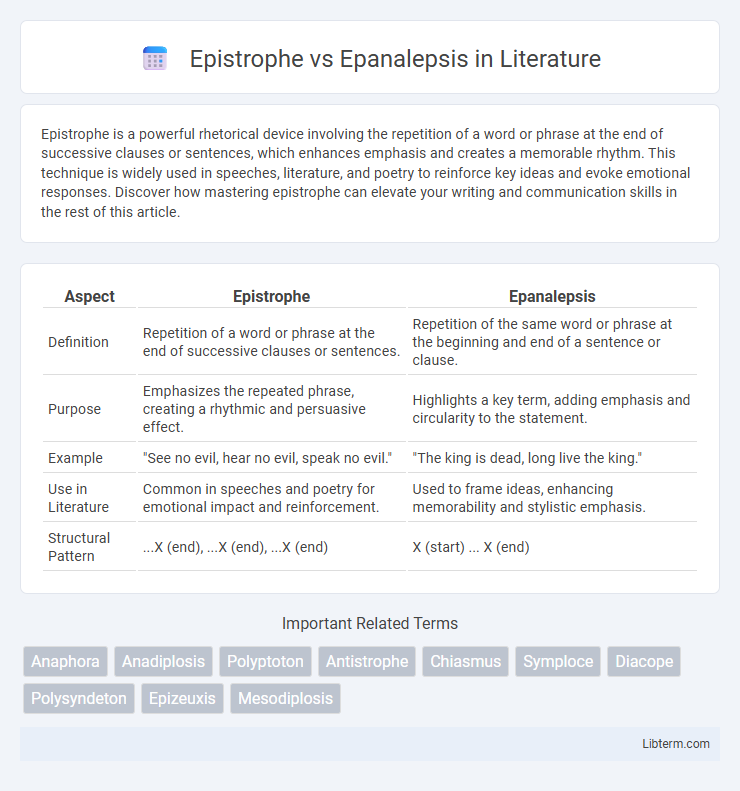Epistrophe is a powerful rhetorical device involving the repetition of a word or phrase at the end of successive clauses or sentences, which enhances emphasis and creates a memorable rhythm. This technique is widely used in speeches, literature, and poetry to reinforce key ideas and evoke emotional responses. Discover how mastering epistrophe can elevate your writing and communication skills in the rest of this article.
Table of Comparison
| Aspect | Epistrophe | Epanalepsis |
|---|---|---|
| Definition | Repetition of a word or phrase at the end of successive clauses or sentences. | Repetition of the same word or phrase at the beginning and end of a sentence or clause. |
| Purpose | Emphasizes the repeated phrase, creating a rhythmic and persuasive effect. | Highlights a key term, adding emphasis and circularity to the statement. |
| Example | "See no evil, hear no evil, speak no evil." | "The king is dead, long live the king." |
| Use in Literature | Common in speeches and poetry for emotional impact and reinforcement. | Used to frame ideas, enhancing memorability and stylistic emphasis. |
| Structural Pattern | ...X (end), ...X (end), ...X (end) | X (start) ... X (end) |
Introduction to Epistrophe and Epanalepsis
Epistrophe is a rhetorical device characterized by the repetition of a word or phrase at the end of successive clauses or sentences, enhancing emphasis and rhythm. Epanalepsis involves repeating the initial word or phrase at the beginning and end of the same clause, creating a circular effect that reinforces the central idea. Both techniques serve to intensify meaning and aid memorability in speech and writing.
Defining Epistrophe
Epistrophe is a rhetorical device characterized by the repetition of a word or phrase at the end of successive clauses or sentences, enhancing emphasis and emotional impact. In contrast, epanalepsis involves repeating the initial word or phrase at the end of the same clause or sentence, creating emphasis through circular structure. Epistrophe is frequently employed in speeches and literature to reinforce key themes and create a memorable rhythm.
Understanding Epanalepsis
Epanalepsis is a rhetorical device where the initial word or phrase of a clause or sentence is repeated at the end, emphasizing the central theme and creating a cyclical structure that enhances memorability. Unlike epistrophe, which repeats words at the end of successive clauses, epanalepsis frames the sentence, reinforcing the primary concept or emotion through strategic repetition. Understanding epanalepsis involves recognizing its power in both poetry and prose to intensify meaning and establish rhythmic balance.
Key Differences: Epistrophe vs Epanalepsis
Epistrophe is a rhetorical device characterized by the repetition of a word or phrase at the end of successive clauses or sentences, enhancing emphasis and rhythm. Epanalepsis involves the repetition of the initial word or phrase of a sentence or clause at its end, creating a circular effect that reinforces the concept. The key difference lies in placement: epistrophe repeats at the end of successive sentences, while epanalepsis repeats the start word or phrase at both the beginning and end of the same sentence or clause.
Historical Origins and Literary Roots
Epistrophe, originating from Ancient Greek rhetoric, involves the repetition of a word or phrase at the end of successive clauses and was notably employed by classical orators like Demosthenes. Epanalepsis, also rooted in Greek tradition, repeats the initial word or phrase of a sentence at its end and appears prominently in the works of Homer and later Shakespearean drama. Both devices serve as powerful rhetorical tools enhancing emphasis and memorability, deeply embedded in the traditions of classical literature and public speaking.
Functions and Effects in Rhetoric
Epistrophe emphasizes repetition of words or phrases at the end of successive clauses to create a powerful rhythm that enhances memorability and emotional impact. Epanalepsis repeats the initial word or phrase of a sentence at its end, framing the message and reinforcing a key concept to heighten emphasis and cohesion. Both devices serve to underscore critical ideas, but epistrophe intensifies passion through cumulative repetition while epanalepsis provides structural symmetry and resolution in rhetoric.
Notable Examples from Literature
Epistrophe is exemplified in Martin Luther King Jr.'s "I Have a Dream" speech, where the repeated phrase "let freedom ring" emphasizes the call for justice. Epanalepsis appears in Shakespeare's "Richard III," as in the line "The king is dead, long live the king," highlighting the cyclical nature of power. These rhetorical devices enhance emotional impact through strategic repetition at sentence endings and beginnings, respectively.
Common Misconceptions and Mistakes
Epistrophe and epanalepsis are often confused due to their repetition of words, but epistrophe repeats a word or phrase at the end of successive clauses, while epanalepsis repeats the initial word or phrase at both the beginning and end of a single clause. A common misconception is using epistrophe in place of epanalepsis, leading to weak rhetorical impact because the structural distinction influences emphasis and rhythm. Mistakes frequently include overlooking the precise placement of repeated words, which diminishes clarity and effectiveness in persuasive or poetic language.
Tips for Using Epistrophe and Epanalepsis Effectively
Epistrophe enhances emphasis by repeating a word or phrase at the end of successive clauses, making it ideal for persuasive speeches and poetic rhythm. Epanalepsis repeats the initial word or phrase at the end of the same sentence, creating a strong framing effect that reinforces key concepts. Use epistrophe to build momentum and emotional intensity, while epanalepsis works best for highlighting central themes and creating memorable statements.
Conclusion: Impact on Communication and Style
Epistrophe, the repetition of words at the end of successive sentences or clauses, creates a rhythmic emphasis that reinforces key ideas, enhancing persuasive and emotional impact. Epanalepsis, repeating the initial word or phrase at the end of the same sentence, offers a circular structure that highlights central concepts, adding dramatic weight and clarity. Both rhetorical devices shape communication style powerfully by engaging audiences and reinforcing messages, but epistrophe often drives momentum across multiple ideas while epanalepsis sharpens focus within individual statements.
Epistrophe Infographic

 libterm.com
libterm.com